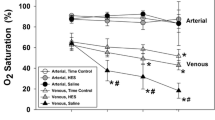Summary
This study was designed to evaluate, in vivo, the effect of a severe non-respiratory acidosis on hemoglobin oxygen transport.
Oxygen affinity of hemoglobin, Bohr effect, Hill's number and red cell 2,3-DPG were evaluated during experimental hemorrhagic shock in dogs. Three periods were considered: control, hypotension (mean arterial pressure 60 mm Hgfor 2 hr 30 min) and blood replacement.
There was no significant change in erythrocyte 2,3-DPG following hemorrhagic hypotension but ATP increased significantly.
n, the Hill number (2.6), was not changed by in vivo acidosis (pH 7.1).
Respiratory Bohr coefficient (B CO2)corresponding to pHe variations was drastically reduced (controlB CO2=0.55, acidosisB CO2=0.31, blood replacementB CO2=0.35).
P50(7.4) was not modified significantly by hemorrhagic acidosis. It is unlikely that variations of blood affinity for oxygen play a major role in oxygen delivery during early experimental hemorrhagic shock.
Similar content being viewed by others
References
Aberkane, H., Azoulay, E., Lecompte, F., Muffat-Joly, M., Pocidalo, J. J.: Transport de l'oxygène par l'hémoglobine au cours de l'hypercapnie aiguë expérimentale. Bull. Physio-Path. Resp.11, 179–192 (1975)
Astrup, P.: Red cell pH and oxygen affinity of hemoglobin. New Engl. J. Med.281, 202–203 (1970)
Astrup, P., Rørth, M., Thorshauge, C.: Dependancy on acid-base status of oxyhemoglobin dissociation and 2,3-diphosphoglycerate level in human erythrocyte. In vivo studies. Seand. J. clin. Lab. Invest.26, 47–52 (1970)
Bellingham, A. J., Detter, J. C., Lenfant, C.: Regulatory mechanisms of hemoglobin oxygen affinity in acidosis and alcalosis. J. clin. Invest.50, 700–706 (1971)
Benesch, R., Benesch, R. E.: The effect of organic phosphates from the human erythrocyte on the allosteric properties of hemoglobin. Biochem. biophys. Res. Commun.26, 162–167 (1967)
Bursaux, E., Freminet, A., Poyart, C. F.: The Bohr effect, the Donnan equilibrium and the estimation of P50 in human whole blood. Bull. Physio-Path. Resp.8, 755–768 (1972)
Chanutin, A., Curnish, R. R.: Effect of organic and inorganic phosphates on the oxygen equilibrium of human erythrocytes. Arch. Biochem. Biophys.121, 96–102 (1967)
Cloutier, C. T., Lowery, B. D., Carey, L. C.: Acid-base disturbances in hemorrhagic shock. Arch. Surg.98, 551–558 (1969)
Crowell, J. V., Smith, E. E.: Oxygen-deficit and irreversible hemorrhagic shock. Amer. J. Physiol.206, 313–316 (1964)
Garby, L., Robert, M., Zaar, B.: Proton and carbamino-linked oxygen affinity of whole blood. Acta physiol. scand.84, 482–492 (1972)
Guest, G. M.: Organic phosphates from the blood and mineral metabolism in diabetic acidosis. Amer. J. Dis. Child.64, 401–408 (1942)
Hohorst, H. J.: L(+) lactate determination with lactic deshydrogenase and DPN. In: H. U. Bergmeyer: Methods of enzymatic analysis. New York: Academic Press 1965
Jacey, M. J., Schaefer, K. E.: The effects of chronic hypercapnia on blood phosphofructokinase activity and the adenine nucleotide system. Respir. Physiol.16, 267–272 (1972)
Meier, U., Böning, D., Rubenstein, H. J.: Oxygenation dependent variations of the Bohr coefficient related to whole blood and erthrocyte pH. Effect of lactic and carbonic acid. Pflügers Arch.349, 203–213 (1974)
Messier, A. A., Schaefer, K. E.: The effect of chronic hypercapnia on oxygen affinity and 2,3-DPG. Respir. Physiol.12, 291–296 (1971)
Messier, A. A., Schaefer, K. E.: The Bohr effect in chronic hypercapnia. Respir. Physiol.19, 26–34 (1973)
Minakami, S., Yoshikawa, H.: Studies on erythrocyte glycolysis. III. The effects of active cation transport, pH and inorganic phosphate concentration on erythrocyte glycolysis. J. Biochem.59, 145–150 (1966)
Naeraa, N., Petersen, E. S., Boye, E., Severinghaus, J. W.: pH and molecular CO2 components of the Bohr effect in human blood. Scand. J. clin. Lab. Invest.18, 96–102 (1966)
Naylor, B. A., Welch, M. H., Schafer, W. A., Guenter, C. A.: Blood affinity for oxygen in hemorrhagic and endotoxic shock. J. appl. Physiol.32, 829–833 (1972)
Poyart, C., Gaudebout, C., Blayo, M. C., Vallois, J. M., Pocidalo, J. J.: Adequate cardiorespiratory functions in mechanically ventilated dogs. Respir. Physiol.9, 318–329 (1970)
Proctor, H. J., Lentz, T. R., Johnson, G.: Alterations in Baboon erythrocyte 2,3-diphosphoglycerate concentration associated with haemorrhagic shock and resuscitation. Ann. Surg.174, 923–931 (1971)
Rossi-Bernardi, L., Roughton, F. J. W.: The specific influence of carbon dioxide and carbamate compounds on the buffer power and Bohr effect in human haemoglobin solution. J. Physiol. (Lond.)189, 1–29 (1967)
Sinet, M., Azoulay, E., Blayo, M. C.: Affinité du sang pour l'oxygène et 2,3-DPG chez l'homme, la femme et la femme enceinte. Bull. Physio-Path. Resp.10, 419–421 (1974)
Sinet, M., Merlet, C., Joubin, C., Blayo, M. C.: Méthode coulométrique de mesure de contenu en oxygène sanguin. Validation par comparaison avec la méthode manométrique de Van Slyke. Rev. Europ. Et. Clin. Biol.18, 1007–1010 (1972)
Tyuma, I., Kamigawara, Y., Imai, K.: pH dependence of the shape of the hemoglobin-oxygen equilibrium curve. Biochim. biophys. Acta (Amst.)310, 317–320 (1973)
Wiggers, C. J.: Physiology of Shock. New York: The Commonwealth Fund. 1950
Wranne, B., Woodson, R. D., Detter, J. C.: Bohr effect: interaction between H+, CO2 and 2,3-DPG in fresh and stored blood. J. appl. Physiol.32, 749–754 (1972)
Author information
Authors and Affiliations
Rights and permissions
About this article
Cite this article
Lecompte, F., Aberkane, H., Azoulay, E. et al. Blood affinity for oxygen in experimental hemorrhagic shock with metabolic acidosis. Pflugers Arch. 359, 147–155 (1975). https://doi.org/10.1007/BF00581284
Received:
Issue Date:
DOI: https://doi.org/10.1007/BF00581284




